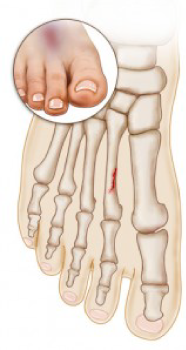Connect With Us
Blog
Items filtered by date: October 2020
How To Tell If You Have a Stress Fracture In Your Foot

Foot Arthritis Doctor Long Beach
Foot Stress FractureA stress fracture is severe bruising or a small crack in the bone. These injuries are common among runners and also athletes who are involved in running sports like basketball and soccer. Stress fractures arise when a person changes their activities. Fractures can also occur when a person is suffering from osteoporosis or some similar disease that weakens their bones. To determine whether you have a stress fracture in your foot, you need to know where it is likely to occur, what causes it, the symptoms associated with this injury, and conditions that mimic stress fractures.
Where Do Stress Fractures Affect?
Stress fractures affect the metatarsals in your foot. When walking or running, the metatarsals are the main areas that are greatly impacted. Stress fractures can also occur in the heel, the outer bone of your ankle and lower leg, the small bone in your ankle joint, and the bone above your mid-foot.
What Causes a Stress Fracture?
A majority of stress fractures are regarded as overuse injuries. Overuse fractures arise when an athletic activity or movement is repeated often. The supporting muscles and weight-bearing bones in your foot do not have sufficient time to heal during exercise sessions.
Another cause of stress fracture is the interruption of the bone’s remodeling process. Your bones are constantly in a state of turnover. This means that new bone is always been replaced by older bone. When an athlete’s activity is excessively great, the older bone breaks down rapidly and outpaces your body’s ability for repairing and replacing it. This causes your bone to grow weak and susceptible to stress fractures.
Many cases of stress fractures arise when a person increases their physical activity. Such an increase can be the result of the frequency of a particular activity like increasing the days you exercise in a given week. It may also be in the form of increasing the intensity or duration of an activity like running for a longer period of time.
Bone fractures can also be caused by conditions like osteoporosis. These conditions decrease your bone’s density and strength making you more vulnerable to a stress fracture.
What Are The Symptoms Of A Stress Fracture?
The most common way to identify a stress fracture in your foot is pain. You will experience pain that develops slowly and gets worse when you continue engaging in weight bearing activities. The other symptoms you should watch out for include:
Pain that goes away when you rest
Pain that intensifies as you engage in your normal activities
Swelling on the exterior part of your ankle or above your foot
Bruising
Tenderness at the area of the foot that is causing you pain
What Conditions Are Easily Confused With Stress Fractures?
Some of the conditions you can mistake for a stress fracture are:
Sprains: These damage the ligament that stabilize your foot joint
Strains: These damage your muscle ortendon
Referred pain from the back: These include conditions such as arthritis or sciatica in the low back of your foot
Morton’s neuroma: This is a growth that affects the nerve that lies between the third and fourth toes of your foot.
Summing It Up
If you suspect you are suffering from a stress fracture, and the pain persists even after you rest or apply first aid, you need to consult a doctor. Your doctor may use surgical or non-surgical methods to relieve the pain. However, many cases of stress fractures are relieved by elevating the foot, placing ice on the affected area, or taking a break from rigorous activity.
Hot to Keep a Positive Mindset Following Achilles Surgery

The Achilles is a very important part of your foot and can have a significant impact on your ability to move around. Those that are athletic could find that having to go through and Achilles heel surgery can be extremely difficult. While the surgery has been completed many times, the process of actually recovering from it can seem very long and frustrating. When going through the achilles surgery recovery, there are a variety of tips that should be followed to ensure you stay in good spirits during the recovery process.
Know Schedule and Stay Current
When you are looking stay in a good mindset after your surgery, the first thing that you need to do is know your recovery schedule and stay current with all types of therapy. Achilles surgery can be a very serious surgery that will take months of therapy. If you are consistent with your surgery, you will continue to see improvements that will be very encouraging. If you fall behind, your entire recovery will be delayed.
Get Outside
One reason why many people start to feel sluggish and depressed after surgery is that they end up spending too much time inside. While you definitely need to get your rest after a surgery, you still need to make sure that you are able to get outside and can be as active as possible. Getting fresh air and seeing some friends will help you to feel connected and will make your recovery go quicker.
Be Healthy
After your surgery, it is also very important that you continue to be as healthy as possible. When you have had your Achilles surgery finished, you obviously will not be able to participate in many of the active sports and exercise programs that you had in the past. However, there are still many ways that you can stay fit and happy while you are going through Achilles surgery recovery. By focusing on some challenging upper body exercises and eating a healthy diet, you can continue to stay fit and feel energized.
Know That It’s a Short Time
When you are in the middle of the recovery, it can seem like the whole process is taking forever. However, you need to do your best to remember that it ultimately is a very short period of time. Instead you should focus on the fact that you will soon be better and will eventually get to return to your favorite activities. This will help you to retain an overall positive point of view.
3 Types of Foot Injuries You Can Experience While Skiing

Skiing is a great way to enjoy the colder weather and get in a little exercise. However, as thrilling as it is, skiing also leaves you susceptible to ski boot foot injuries injuries, especially of the feet and ankles. Know what kind of injuries to look out for and how to protect your feet to avoid injuries the next time you hit the slopes.
3 Most Common Skiing-Related Foot Injuries
- Strains and Sprains
A foot sprain occurs when the ligaments, or tough bands that connect your bones in the joint, of your foot become strained or torn. With skiing this generally occurs as the result of a fall during which you land on the outside of your foot, causing it to twist inward. A sprain might also be the result of your ski tip getting caught in the snow and the boot not being released quickly enough. In either case, you may experience mild to moderate pain, swelling, tenderness, and bruising. In severe cases, you may be unable to bear weight on your injured foot. - Fractures and Breaks
Fractures and even complete breaks of bones in your feet and ankles are not uncommon with skiing. Unfortunately, this is the case even though your foot is encased in a firm, stable boot while skiing. In fact, one of the particularly common ski boot foot injuries is a break known as a “boot top” fracture and typically results when a fall occurs with enough force to break the bones at the top of the foot or above the boot. Stress fractures are of particular concern to skiers as they are often slow to show symptoms and may present with symptoms similar to that of a strain or sprain. - Bumps and Bruises
It may be tempting to ignore what seem like minor bumps and bruises, but even these issues can lead to more serious concerns. One of the most common of which is known as “skier’s toe.” This skiing foot injury is typically the result of boots that are too tight or too loose and causes bleeding under the toenail. The injury typically develops as discoloration and soreness of your big toe, but it can sometimes cause the entire nail to turn black. While not too serious if it’s treated appropriately, it can become more of an issue if it’s not remedied correctly.
Tips to Protect Your Feet While Skiing
Like with most injuries, prevention is the best medicine. So before you head out for your next ski adventure, be sure to follow these tips:
- Make sure your boots are properly fitted to your feet and in good condition.
- Invest in socks and other quality equipment to keep your feet dry and warm.
- Condition your body with some aerobic and endurance exercises beforehand.
- Warm up and stretch out your legs, feet, and ankles prior to hitting the slopes.
- Avoid overworking your muscles and take a break if you’re feeling fatigued.
If you do suspect a skiing foot injury following your time on the slopes, it’s best not to ignore it, as many ski-related foot injuries can lead to long-term issues if left untreated. Take care of your feet and the rest of your body by seeing a medical professional for a proper diagnosis.
The Difference Between an Ankle Strain and an Ankle Sprain

Ankle Surgery Long Beach
Strains and sprains are two common injuries your ankle may suffer. Whether due to a sports injury or simply your foot twisting off the sidewalk, both are painful and, when not properly taken care of, can linger for long periods of time. If you suffer any kind of ankle injury it is important to come in and have it looked into right away. While you may know when your ankle is broken, here are the differences between an ankle strain and an ankle sprain.
What is an Ankle Sprain
An ankle sprain is when the ligaments in your ankle either tear or stretch. Due to this, there are varying levels of a sprain. A sprain often sounds less painful or time-consuming than a break. However, if the ligament completely tears it will take time for it to mend.
The ligaments in question within the ankle are bands that connect the two bones of your ankle together.
What is an Ankle Strain
An ankle strain is a bit different from a sprain. The strain is a tearing of the tendon or muscles. A tendon is a cord of tissue that connects muscles to your bones. When a strain occurs on your ankle it’s usually right around the hamstring muscle on the back side of your thigh.
Treating Ankle Strains and Sprains
Much of the treatment with regards to a strain and sprain are the same. You’ll want to stay off of your foot, ice the injury, elevate it anyplace pressure on it. A mild can be treated without much in way of medical treatments. In this instance, it’s a stretch of the ligament and it just needs some time. When you see the doctor you may be given crutches to help keep weight off your foot, but for the most part, you don’t need to do anything else but wait.
Serious strains and sprains are different. In these instances, you may need a surgical procedure. Torn ligaments and separated muscles or tendons are not only painful but may prevent your ankle and muscles from functioning correctly. Additionally, the torn or separated tissue may fuse back onto the bone incorrectly, which will hinder movement permanently (unless it is surgically disconnected and attached in the correct location).
Common Symptoms
Symptoms of an ankle strain and sprain are similar, but if you know what to look out for you can tell the difference. You will suffer from pain and swelling with each injury (ice and pressure can help keep swelling down). In the event of a sprain, you’ll have very limited ability to move your joint. You might also hear a “pop” sound in your joint. In the event of a strain injury, you may suffer from muscle spasms after the injury. You’ll also find it difficult to move the affected muscle. So with a sprain, you might not be able to move your ankle, while with a strain you might not be able to flex your muscle.
It is extremely important to see a medical professional following any kind of ankle injury, so you know the extent of the problem and what needs to be done to correct it.
COVID-19 Toes Are Real And Here’s How You Can Identify Them

here has been a slew of coronavirus information circulating the internet. One of the most common things to see is information relating to the symptoms of COVID-19.
What Exactly Are “COVID Toes”
And that is not surprising. As more research is done, the medical field is learning more and more about how coronavirus manifests itself.
One of the most shocking things is the one can be infected and only see one minor symptom, such as a stomach ache, or, recently discovered, something called, “COVID toes”.
That’s right. Dr. Esther Freeman, a dermatologist at Massachusetts General Hospital in Boston, first diagnosed this skin condition as a symptom of coronavirus. The skin becomes a red or purple discoloration and may become raised or develop ulcerations. This not only appears on the feet but may affect the hands as well.
“Other skin symptoms have been shown to manifest in COVID-19 positive patients, but this seems to be “COVID-specific,” Dr. Lindy Fox, professor of dermatology at the University of California, San Francisco, explains.
Possible symptoms of “COVID toes”
- Skin that is hot, burning, or itchy.
- “Purple, red bumps/discoloration” on the tips of digits and pads, or on the tops of toes or sides of feet.
- Irritated, or raised skin with ulcerations.
While there is on-going research as to what is the cause of these symptoms, Freeman believes that one reason may be that there’s just a lot of overall inflammation caused by the virus.
Others think that it may also be due to blood vessel clots, which can occur in COVID-19 patients.
“If you notice discoloration on your feet or other hallmarks of COVID toes, contact a dermatologist and ask to be tested for COVID-19” Freeman recommends.
While there is not any particular cure for COVID toes at this time and there is no accurate data as to how many are being affected, it is important to stay vigilant and contact our office if in any way one thinks that they are experiencing COVID-19 symptoms.

